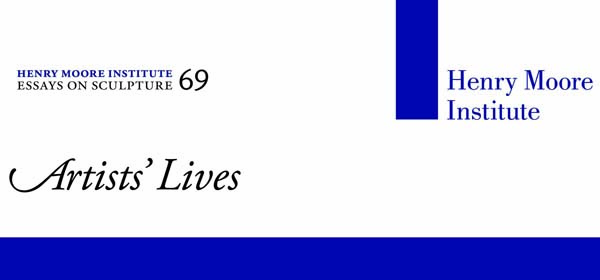We are pleased to announce that the Henry Moore Institute: Essays on Sculpture series is now distributed in North America by Old City Publishing, Inc.
Essays on Sculpture is the journal of the Henry Moore Institute. Published three times a year, each issue focuses on a different aspect of the institute’s research, collections, and exhibitions.
The following issues are currently in-stock and available from the OCP online store.
Helen Chadwick’s ‘Ego Geometrica Sum’: A Biography (No. 64)
Leonie O’Dwyer
The papers of the artist Helen Chadwick (1953-1996) are one of the key collections held in the Henry Moore Institute Archive of Sculptors’ Papers. This record spans Chadwick’s years in Art College in the early-mid 1970s through to her sudden, early, death in 1996.
In 2007 the art historian Leonie O’Dwyer began working on this material to create a critical catalogue raisonné of Chadwick’s works, developing her research through an Arts and Humanities Research Council collaborative doctoral project, undertaken at Leeds University and the Henry Moore Institute. This sixty-fourth edition in the Institute’s Essays on Sculpture series is the first publication of O’Dwyer’s research on Chadwick. It focuses on a selection of material relating to the installation ‘Ego Geometria Sum’ of 1982-83, tracing the biography of this influential work that rethought the possibilities of sculpture.
Bad Copies: The Drawings of Phyllida Barlow (No. 65)
The sculptor Phyllida Barlow has described her drawings as ‘bad copies’: rough approximations of things she has seen. In these works she takes forms and objects from the real world and reconfigures them in line with her own sculptural concerns. Her practice of drawing has run alongside and informed the making of her three-dimensional work throughout her career.
In 2011 Barlow revisited her archive of drawings, looking back at the process of her sculptural development. This text marks this moment of review and accompanies Bad Copies, the first exhibition of drawings from her archive. This issue of our journal features an essay on Phyllida Barlow’s drawings and has an interview with the artist.
1913: The Shape of Time (No. 66)
Jon Wood, with a timeline compiled by Pavel S. Pyś
Individual years have often caught the attention of cultural theorists and historians of art, literature and ideas, offering up snapshot insights into groundbreaking moments of cultural change. It is easy to see why 1913 has received such attention, given the compelling power of so many of the artworks made in this year.
This issue of Essays on Sculpture investigates how sculpture was uniquely positioned in 1913 to give shape to new ideas through its materiality, spatiality and the power of its ancient figurative traditions. It was published on the occasion of the exhibition 1913: The Shape of Time. Artists discussed include Alexander Archipenko, Vladmir Baranov-Rossiné, Umberto Boccioni, Giorgio de Chirico, Marcel Duchamp, Jacob Epstein, Emil Filla, Henri Gaudier-Brzeska, Eric Gill, Otto Gutfreund, Wilhelm Lehmbruck, Amedeo Modigliani, Pablo Picasso, and Ardengo Soffici.
Books and Sculpture (No. 67)
Lisa Le Feuvre and Fraser Muggeridge
Issue 67 of the Henry Moore Institute’s journal Essays on Sculpture explores how sculpture has been represented in books. Focusing on eight books published between 1916 and 1971, this issue features a transcript of a discussion between Le Feuvre and Muggeridge, that took place at the 2012 London Art Book Fair, with notes on each publication.
Ranging from Ezra Pound’s Gaudier-Brzeska: A Memoir (1916) to Frederick Kiesler’s Contemporary art applied to the store and its display (1930), Circle: international survey of constructive art (1937), and Lucy Lippard’s 955,000 (1970), the selection of books deploys 3-D glasses, texture and varying page weights, multiple views of sculpture, expanding pages and textual descriptions to try capture sculpture on the page.
My Life by Anton Lesseman (No. 68)
Paul Becker
Paul Becker, a 2011 Research Fellow, tells the story of the sculptor Anton Lessemann, an unknown, and fictional, contemporary of Henry Moore. Featuring extracts from Lesseman’s autobiography, illustrated by sketches, paintings, letters and sculptures, and an interview between Paul Becker and Jon Wood (Research Curator at the Henry Moore Institute), this publication is an exploration of the imaginary artist and the role of fiction in art making.
Artists’ Lives (No. 69)
The voice of the sculptor is paramount importance to the study of sculpture, and this issue of the journal Essays on Sculpture is committed to that subject. Artist’s Lives is one of a number of projects run by the British Library’s National Life Stories, a project committed to recording first-hand experiences from as wide a cross section of society as possible. A number of selected extracts are presented here to demonstrate the depth and breadth of these recordings, alongside reflections by some of the artists and their interviewers.

